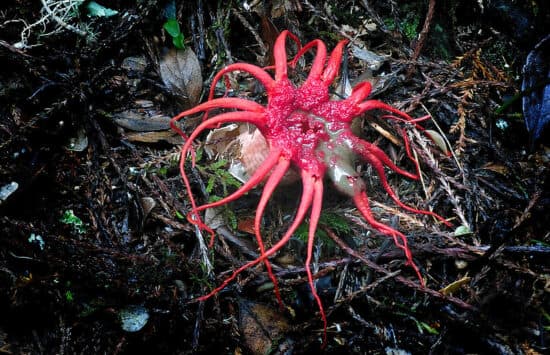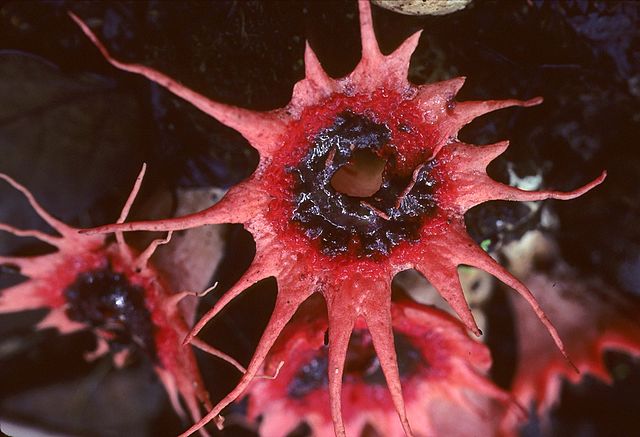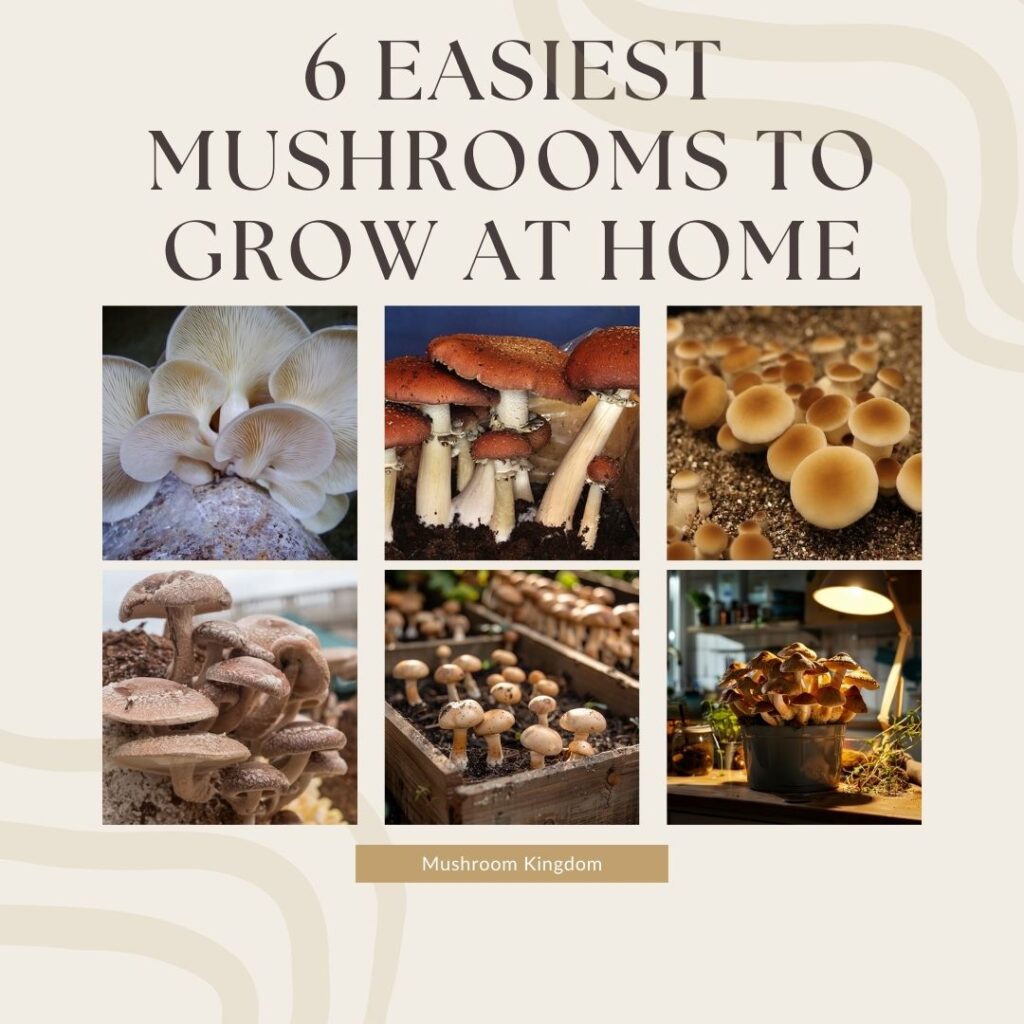In this article, we will explore the fascinating world of anemone stinkhorn fungi, covering its identification features, edibility, habitats, etymology, ecological role, and similar species.
We’ll also share some intriguing facts about this unique and often misunderstood fungus.

What is Anemone Stinkhorn?
Anemone stinkhorn, scientifically known as Aseroe rubra, belongs to the phalloid fungi family.
Recognizable by its distinctive, star-like structure and foul odor, this mushroom often intrigues and repulses those who encounter it.
Named after its uncanny resemblance to sea anemones and its pungent smell, anemone stinkhorn plays a unique role in nature.
This fascinating fungus first appears as a whitish egg-like structure. Over time, it ruptures, releasing a slender stalk topped with a striking, star-shaped cap adorned with bright red arms.
The arms often curl upwards, giving it an otherworldly appearance. While its smell may deter humans, it attracts insects, particularly flies, which help disperse its spores.
How to Identify Anemone Stinkhorn?
This section will help you recognize this unique fungus by focusing on its appearance, odor, habitat, and seasonal growth patterns.
Appearance
Initially, Aseroe rubra appears as a white or pale egg-like structure nestled in the soil. As it matures, this “egg” splits open, revealing a hollow, cylindrical stalk that can reach a height of 4–12 centimeters.
The most distinctive feature of anemone stinkhorn is its star-shaped cap, which consists of 6–10 reddish-orange arms.
These arms tend to curl upwards and are sticky to the touch, covered in a dark, foul-smelling slime known as gleba. This slime plays a crucial role in the fungus’s reproduction by attracting insects that help disperse its spores.

Odor
One of the most notable characteristics of Aseroe rubra is its strong, putrid odor, which closely resembles the smell of decaying organic matter.
While this scent is unpleasant to humans, it serves an important ecological function.
The foul odor attracts insects, particularly flies, which are drawn to the gleba. As these insects feed on the slime, they inadvertently collect and disperse the spores, aiding in the propagation of the fungus.
Habitat
This fungi typically grows in moist, nutrient-rich soils. You can often find it thriving in gardens, where the soil is regularly watered and fertilized. Compost piles also provide an ideal environment, as the decomposing organic matter creates a rich, humid substrate.
Additionally, wooded areas with decaying leaves and wood offer suitable conditions for the growth of Aseroe rubra. Its ability to adapt to various environments makes it a common sight in both natural and urban settings.
Season
The growth is closely tied to warm, wet weather conditions. It usually appears during periods of high humidity and can be found throughout the year in tropical and subtropical regions.
In these climates, the fungus has a continuous growing season, allowing it to thrive and spread. However, even in temperate regions, you may spot them during particularly wet and warm periods.
By paying close attention to these identifying features — its distinctive appearance, foul odor, preferred habitats, and seasonal growth patterns — you can easily distinguish anemone stinkhorn from other fungi.
Is Anemone Stinkhorn Edible?
Although anemone stinkhorn is not toxic, it is not considered edible due to its foul smell and unappetizing appearance.
The gleba, which covers the arms, emits a strong odor to attract insects for spore dispersal. This slime makes the mushroom less appealing for culinary purposes.
While some cultures may utilize various fungi for medicinal or ritualistic purposes, there is no significant documentation on the consumption of this fungi.
Most mycologists and foragers advise against eating it, mainly because of its repugnant odor and lack of culinary value.
Where Can You Find Anemone Stinkhorn?
Anemone stinkhorn predominantly inhabits tropical and subtropical regions. It prefers humid environments and rich, organic soils. Common places to find this unique fungus include:
- Gardens: The rich soil and frequent watering in gardens provide an ideal environment.
- Compost Piles: Decomposing organic matter in compost piles creates a nutrient-rich habitat conducive to its growth.
- Wooded Areas: Decaying wood and leaf litter in forests offer suitable conditions forAseroe rubra to thrive.
- Urban Areas: Even in urban settings, this mushroom can be found in parks, roadside verges, and other green spaces.
- Geographical Distribution: While native to Australia, anemone stinkhorn has spread to various parts of the world, including North and South America, Asia, and Europe, due to the movement of soil and plant materials.
Anemone Stinkhorn Etymology
The name “anemone stinkhorn” reflects both its appearance and odor. The term “anemone” refers to its resemblance to the sea anemone, a marine creature with similar radiating arms. “Stinkhorn” is a common name given to various fungi in the Phallaceae family, characterized by their phallic shapes and foul smells.
The scientific name, Aseroe rubra, also holds specific meanings. “Aseroe” derives from Greek, where “aser” means disgusting or offensive, and “roe” refers to the cap’s resemblance to a sea anemone. “Rubra” is Latin for red, indicating the vivid color of the arms.
Similar Species to Anemone Stinkhorn
While Aseroe rubra stands out due to its unique appearance, several fungi share similarities. These include:
- Dog Stinkhorn (Mutinus caninus): This species has a similar phallic shape but lacks the star-like arms. It also emits a foul odor to attract insects.
- Elegant Stinkhorn (Mutinus elegans): With a bright orange or red cap and slender stalk, this fungus resembles anemone stinkhorn but has a more elongated structure.
- Devil’s Fingers (Clathrus archeri): Known for its tentacle-like arms and red color, devil’s fingers also emit a strong odor. However, its arms emerge from a single base, differentiating it from anemone stinkhorn’s star-like formation.
Understanding these differences helps in accurately identifying anemone stinkhorn and appreciating its unique characteristics.
Fun Facts About Anemone Stinkhorn
- Unique Reproductive Strategy: The anemone stinkhorn’s use of insects for spore dispersal is a fascinating example of nature’s ingenuity. This mutualistic relationship benefits both the fungus and the insects.
- Rapid Growth: This fungus can grow rapidly, with the fruiting body emerging and maturing within a few days. This swift development is a testament to its adaptability and resilience.
- Cultural References: Despite its off-putting smell, this fungus has captured the interest of various cultures. In some regions, it is considered a symbol of rebirth and transformation due to its life cycle and unique appearance.
Conclusion
Anemone stinkhorn (Aseroe rubra) is a remarkable fungus that stands out in the fungal kingdom.
From its star-like structure and pungent odor to its ecological role and unique reproductive strategies, this mushroom exemplifies the diversity and complexity of fungi.
Whether you encounter it in a garden, forest, or urban park, understanding anemone stinkhorn’s characteristics and significance can enhance your appreciation for the natural world.


